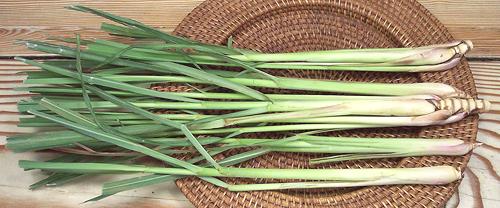 [Fever Grass, Lemon Grass;
Ta Khrai, Takrai (Thai); Xa, Sa chanh (Viet); Tanglad (Philippines);
Zabalin (Burma); Si khai, Sing khai (Laos); Bai mak nao, Slek krey
sabou, Kuel skey (Cambodia); Sera (Sri Lanka, India); Ghanda,
Bhustrina (India); Serai (Malaysia); Sereh (Indonesia); Citronella
(French); Cymbopogon citratus and to a lesser extent other
Cymbopogon species]
[Fever Grass, Lemon Grass;
Ta Khrai, Takrai (Thai); Xa, Sa chanh (Viet); Tanglad (Philippines);
Zabalin (Burma); Si khai, Sing khai (Laos); Bai mak nao, Slek krey
sabou, Kuel skey (Cambodia); Sera (Sri Lanka, India); Ghanda,
Bhustrina (India); Serai (Malaysia); Sereh (Indonesia); Citronella
(French); Cymbopogon citratus and to a lesser extent other
Cymbopogon species]
Lemon scented grasses native to Southeast Asia. C. citratus is essential to the cuisines of all of Southeast Asia, including the Philippines. It is also used in Sri Lanka, parts of southern China, and in the Caribbean, but is not used in cooking in India.
C. flexuosus, intensively grown in India, is mostly used for oils, perfumes and medicinals, though it can be used in cooking.
C. nardus is the industrial strength version, unpalatable to both people and livestock, but distilled into citronella oils used as insect repellents, antiseptics and flavorings. It is grown as a decorative in Florida and California but is a serious and difficult to defeat invader of pasture land in Africa.
More on Grasses & Grains.
Some Asian markets will have packages of pre-chopped lemongrass in the frozen food cases. This is not quite as good as fresh but it is usable in recipes. Dry powdered lemongrass can sometimes be found but it's really hardly worth using - the flavor and aroma are pretty much gone.
To use whole, strip off the tough outer leaves, cut the hard root back until you see purple rings. Smash moderately with your kitchen mallet (a plug of root is likely to pop out), then cut the bottom end into two 3 inch lengths, discarding the top.
To chop, prepare as for using whole except don't cut off the top. Smash well with your kitchen mallet, then cut crosswise as thin as you can, and finally chop. Use about the bottom 4 to 5 inches and discard the tops. For some applications (particularly curry pastes) you'll want to pound the finely chopped lemongrass to a paste in a big stone mortar.